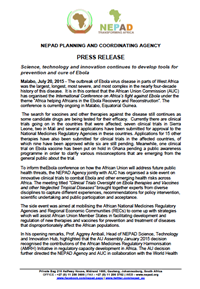Dakar, Senegal, July 22, 2015 – “Agriculture can lift more people out of poverty than any other sector in Africa,” said Dr. Marcel Nwalozie, Head of the NEPAD Agency’s office in Senegal.
Dr. Nwalozie was addressing participants of the Comprehensive Africa Agriculture Development Programme (CAADP) Information Support Seminar for Ministries of Agriculture in Dakar, Senegal.
Underscoring the catalytic role of agricultural in alleviating poverty, Angelique Uwimana, Knowledge and Communication Officer, reported that in the recent years rural poverty in Rwanda fell more than urban poverty due to an increase in agriculture. Between 2008 and 2012, rural poverty in Rwanda fell from 61.9% to 48.7%, and because of growth in agriculture, poverty fell by 12% since the adoption of CAADP in that country in 2009.
Participants highlighted that although the NEPAD Agency has supported several communication and information sharing initiatives there remains a need for greater coherence in communicating agricultural messages across different sectors. Consistency and harmonisation in communicating CAADP – Africa’s agricultural transformation agenda - emerged as key in transforming agriculture for growth and inclusive development.
The aim of the seminar in Dakar was to raise the level of awareness of CAADP’s role in boosting agricultural growth in Africa. At the same time, participants were sensitized to CAADP’s Implementation Strategy and Roadmap to Achieve the 2025 Vision as contained in the 2014 Malabo Declaration and its commitments on agriculture for the next ten years.
Participants at the seminar also shared experiences on agriculture and CAADP’s impact, best practices and country-specific lessons. Issa Moussa, Director of Communications at the Ministry of Agriculture of Togo, reported that evidence from his country shows that there is a steady increase in job creation through agriculture. Director of Policy, Statistics, M& E and Cooperation in the Mauritanian Ministry of Agriculture, Abdellahi Zeyad, stated that since the adoption of CAADP in Mauritania, part of the impact on agriculture has been an increase in irrigation, which in turn has led to diversification in production, as well as job creation.
Presentations from post-conflict countries like Madagascar and Congo-Brazzaville showed that conflict disrupts agricultural output and has a negative impact on food security and nutrition. Nonetheless, the implementation of CAADP in those countries is helping to turn the situation around by providing clarity on planning for priority areas.
In Rwanda, for example, before the adoption of CAADP in 2009, the national budget allocation towards agriculture was less than 3 percent, but the post-CAADP years have seen an increase of between 8 and 12 percent.
The seminar was attended by government communication representatives and media from 12 countries - Burkina Faso, Chad, Comoros, Congo, Cote d’ Ivoire, Madagascar, Mauritania, Senegal, Togo, Rwanda, South Africa and Zambia.
The seminar concluded that National Agriculture Investment Plans are important sources of information for monitoring and evaluation, as well as key sources for crafting advocacy messages to boost agricultural growth in Africa.
-- END--
Source: NEPAD
For more information and interview contact:
Name: Mrs Mwanja N’ganjo
Number: +27 11 256 3615
Email: MwanjaN@nepad.org




